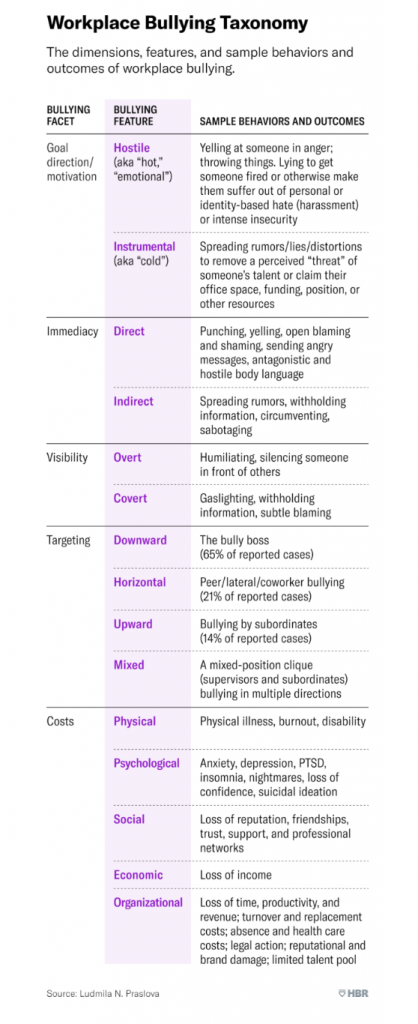Scenario 1:
Harish mails the report to his boss before leaving the office and when he is about to make a move his boss calls him inside his cabin and says “You call this a report? How can you not present the data in excel even after these many years of experience?
Scenario 2:
Harish mails the report to his boss before leaving the office and when he is about to make a move his boss calls him inside his cabin. Two other managers are available in the room. The boss appreciates himself for mentoring Harish and congratulates him for the collective work on the report. But there is no mentorship or collective work here.
Scenario 3:
Harish mails the report to his boss before leaving the office. The boss takes the report and presents it to higher-ups as if he alone prepared the data. The boss also spread rumours that Harish is not making any significant contribution.
In all the above three incidents, what Harish is going through is “workplace bullying”. Workplace bullying is difficult to address due to its wide and complex range of behaviours. Based on her 25+ years of research expertise and practice in this area, Ludmila has identified 15 different types of bullying in the workplace. The types, sample behaviours and outcomes are explained in Fig 1.

It is important to note here that in a recent HBR article, the percentage of employees in India being bullied at work has been reported to be as high as 46% to even 55%. Given bullying’s complex nature and the hierarchical model followed in India, there is also a possibility that this percentage could be even higher as employees may not be even aware that there are being bullied.
Workplace bullying, is defined as a form of interpersonal misconduct at the workplace that involves repeated demeaning or destructive behaviors towards others. It is considered one of the greatest social stressors, having a negative impact on targets, witnesses, harassers, and even the organizations in which these behaviors occur.
Researchers highlighted that bullying not only has adverse physiological and psychological effects (e.g., psychosomatic symptoms, anxiety, depression, and suicide) but also has a significant impact on to productivity (e.g., intention to leave, absenteeism, and job dissatisfaction).
Given the negative consequences of workplace bullying, researchers have made great efforts in identifying “Personality Traits” (an individual’s thoughts, feelings and behaviour) as one of the main reasons behind this complex behaviour. The extant research on personality traits as antecedents of workplace bullying has usually been studied from the Five Factor model.
Based on meta-analysis (study that statistical analyses multiple studies in this area), researchers identified that victims’ belong mostly to Neurotic Type (Persons with high scores on this trait are characterized by feelings of nervousness, worrying, and insecurity) and bullies scored low on agreeableness (respect for individual differences, cooperativeness and social harmony) and high on extraversion (tendency to be outgoing, sociable, interested in other people, assertive and active).
Based on the systematic research (study that summaries the results of several studies in this area), researchers recently identified that the bullies may be disagreeable, sadistic, selfish and manipulative.
Based on the systematic research (study that summaries the results of several studies in this area), researchers recently identified that the bullies may be disagreeable, sadistic, selfish and manipulative.
It is important to note the researchers who have studied the cause of bullying through the lens of “Personality Traits” have suggested using personality test for hiring talent, using the reports of the test for actively monitoring the behaviour of potential perpetrators (bullies) and victims and providing training programs like conflict management as and when required.
The question here is the possibility of implementing the above suggestions in developing countries like India considering cut-throat competitions among organizations, the talent war in the market, maturity of the organizations in handling sensitive issues and the availability of resources for continuous monitoring and training.
References:
Dåderman, A. M., & Ragnestål-Impola, C. (2019). Workplace bullies, not their victims, score high on the Dark Triad and Extraversion, and low on Agreeableness and Honesty-Humility. Heliyon, 5(10),
e02609.
Fernández-del-Río, E., Ramos-Villagrasa, P. J., & Escartín, J. (2021). The incremental effect of Dark personality over the Big Five in workplace bullying: Evidence from perpetrators and targets. Personality and individual differences, 168, 110291.
Nielsen, M. B., Glasø, L., & Einarsen, S. (2017). Exposure to workplace harassment and the Five Factor Model of personality: A meta-analysis. Personality and individual differences, 104, 195-206.
Özer, G., & Escartín, J. (2023). The making and breaking of workplace bullying perpetration: A systematic review on the antecedents, moderators, mediators, outcomes of perpetration and suggestions for organizations. Aggression and violent behavior, 101823.
About the Author


